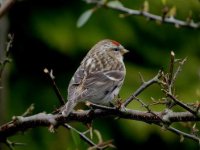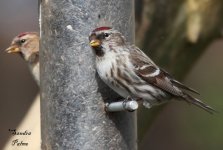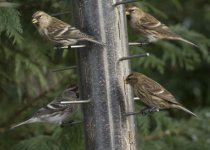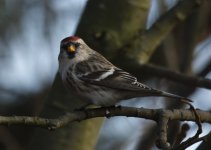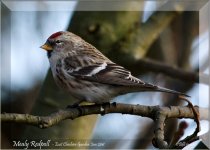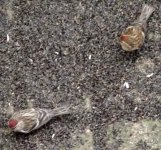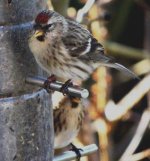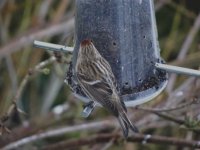-
Welcome to BirdForum, the internet's largest birding community with thousands of members from all over the world. The forums are dedicated to wild birds, birding, binoculars and equipment and all that goes with it.
Please register for an account to take part in the discussions in the forum, post your pictures in the gallery and more.
You are using an out of date browser. It may not display this or other websites correctly.
You should upgrade or use an alternative browser.
You should upgrade or use an alternative browser.
Anyone for Meally.....? (1 Viewer)
- Thread starter KenM
- Start date
More options
Who Replied?KenM
Well-known member
The most obvious thing about Mealy Redpoll is that it is larger than Lesser Redpoll. If it was not obviously larger, then it was a Lesser. Both vary in colouration.
I've noted size and slight structural variation in Lesser (shorter broader as against narrower and more attenuated..bigger in overall size if you like)...Are you suggesting that Meally enjoys a 'size constant' and fluctuates only in the cosmetic department..ie a 'big lesser' couldn't be confused with a standard Meally?
Kingfisher21
Well-known member
Lesser for me - still looks too (warm) brown to me, the wing bars aren't white/prominent enough and I would expect a white(r) rump. The bird also doesn't look chunky enough, even without other birds in the photo for size comparison.
On primary projection only, you have not quite 100% so that places the bird in the Lesser Redpoll camp. You can see the rump between the wingtips and it is most def brown so again a factor for lesser.
KenM
Well-known member
On primary projection only, you have not quite 100% so that places the bird in the Lesser Redpoll camp. You can see the rump between the wingtips and it is most def brown so again a factor for lesser.
Even allowing for fore-shortening...the PP appears to be equal to the tertials, was not aware of any wing-biometric difference between the two 'taxon?'
To my eye the rump is paler than the tail/mantle...indeed..I believe this is variable at best..and must be viewed as part of a 'suite' of supporting criteria, and cannot be seen as a stand alone feature?
Kingfisher21
Well-known member
Mmmm not sure how many more factors you need.... A mealy just totally stands out like a sore thumb in a group of lessers, as 'creedence' first stated. If it looks 'a little different' and you have to look closely to maybe make it into a mealy, it isn't a mealy. Your bird here looks like a typical lesser, it does not have the pale/grey appearance of a mealy, lacks the pure white wing bars and the white rump and looks small and 'delicate'. PP has also been mentioned. Here's a mealy with a lesser in the background:
A mealy just totally stands out like a sore thumb in a group of lessers, as 'creedence' first stated. If it looks 'a little different' and you have to look closely to maybe make it into a mealy, it isn't a mealy. Your bird here looks like a typical lesser, it does not have the pale/grey appearance of a mealy, lacks the pure white wing bars and the white rump and looks small and 'delicate'. PP has also been mentioned. Here's a mealy with a lesser in the background:
Attachments
Bananafishbones
Incoherently Rambling .....

I would agree with Lesser for the reasons already given. Here is a good comparison shot, note the structure difference, the bull neck, the Jizz is different. I watched this Mealy in the garden for 3 months with upto 50 Lessers everyday and it always stood out, when you see one especially in a flock I think it is obvious with all the ID features standing out easily.
Dave
Dave
Attachments
jpoyner
Well-known member

Doesn't look anything like the Lessers that have been coming to my feeders all winter and that's about as scientific as I'll go! Then again, nor do the "Lessers" that breed on the West Coast of Scotland, or come to think of it the one's that breed in the Hebrides which don't look like either. It's certainly a Redpoll.
KenM
Well-known member
So far an interesting response...I..perhaps not unlike some of the respondents to this thread, am a niger pusher, and as such, am used to Redpolls on a daily basis and in (close proximity..up to 6' on a daily basis, for between 7-8 months per year).
Thus I am relatively seasoned as far as size and cosmetic variability are concerned, as has been stated..once you see something different it shows..like a 'sore thumb'. I'm also aware of the 'sensor' bias in most cameras, especially if the subject is 'reasonably well lit', there might just be a propensity to 'contrast the whites' without any post editing interference. Thus we tend to image those birds that..stick out from the ''Lesser'' herd, Indeed without the comparison birds, we might feel less confident? My posted image was just that! cosmetically very different from the rest. Here are a few more images to hopefully whet the appetite (the last two birds from last year had small white rumps, and were demonstrably bigger than their cohorts) . FWIW Banana! I'd be interested in what US observers might 'opinion to'...regarding your Meally on the feeder with 3 Lesser Redpolls image?
Thus I am relatively seasoned as far as size and cosmetic variability are concerned, as has been stated..once you see something different it shows..like a 'sore thumb'. I'm also aware of the 'sensor' bias in most cameras, especially if the subject is 'reasonably well lit', there might just be a propensity to 'contrast the whites' without any post editing interference. Thus we tend to image those birds that..stick out from the ''Lesser'' herd, Indeed without the comparison birds, we might feel less confident? My posted image was just that! cosmetically very different from the rest. Here are a few more images to hopefully whet the appetite (the last two birds from last year had small white rumps, and were demonstrably bigger than their cohorts) . FWIW Banana! I'd be interested in what US observers might 'opinion to'...regarding your Meally on the feeder with 3 Lesser Redpolls image?
Attachments
Even allowing for fore-shortening...the PP appears to be equal to the tertials, was not aware of any wing-biometric difference between the two 'taxon?'
To my eye the rump is paler than the tail/mantle...indeed..I believe this is variable at best..and must be viewed as part of a 'suite' of supporting criteria, and cannot be seen as a stand alone feature?
Advanced Bird ID Handbook, quotes pp on lesser as < or = to 100% whilst mealy as >100%.
Laruslister
Well-known member
Get ready for when the scientists "lump"all Redpolls together again as is likely to happen...it's starting to be seen as just cline ,and that is why scottish west coast lessers are paler.Here is an article on the subject:-
Low support for separate species within the redpoll complex (Carduelis
flammea–hornemanni–cabaret) from analyses of mtDNA
• Gunnhild Marthinsen
• Liv Wennerberg,
• Jan T. Lifjeld
• Natural History Museum, University of Oslo,
The redpoll complex, consisting of three currently recognized species
(Carduelis flammea, C. hornemanniand C. cabaret), is polytypic in
biometry, morphology, physiology and behaviour. However, previous
genetic work has not revealed any indications of genetic
differentiation. We analysed sequence variation in the mtDNA control
region, and allele frequencies of supposedly faster evolving
microsatellites (n = 10), in an attempt to detect molecular geneticsupport for the three species, as well as two subspecies of C.
flammea(ssp. flammea and rostrata), within this complex. We used
samples from two subspecies of the twite (Carduelis flavirostris, ssp.
flavirostris and rufostrigata) as outgroup. We found no structure
among redpoll individuals in mtDNA haplotypes or microsatellite allele
frequencies, and only marginal differences between redpoll taxa in
analyses of molecular variance (AMOVAs) of predefined groups. In
contrast, the two twite subspecies constituted two well-supported
monophyletic groups. Our study thus strengthens previous indications
of low genetic support for current redpoll taxa. Two major alternative
interpretations exist. Either redpolls form a single gene pool with
geographical polymorphisms possibly explained by Bergmann’s and
Gloger’s rules, or there are separate gene pools of recent origin
but with too little time elapsed for genetic differentiation to have
evolved in the investigated markers. Future studies should therefore
examine whether reproductive isolation mechanisms and barriers to gene
flow exist in areas with sympatric breeding.
Low support for separate species within the redpoll complex (Carduelis
flammea–hornemanni–cabaret) from analyses of mtDNA
• Gunnhild Marthinsen
• Liv Wennerberg,
• Jan T. Lifjeld
• Natural History Museum, University of Oslo,
The redpoll complex, consisting of three currently recognized species
(Carduelis flammea, C. hornemanniand C. cabaret), is polytypic in
biometry, morphology, physiology and behaviour. However, previous
genetic work has not revealed any indications of genetic
differentiation. We analysed sequence variation in the mtDNA control
region, and allele frequencies of supposedly faster evolving
microsatellites (n = 10), in an attempt to detect molecular geneticsupport for the three species, as well as two subspecies of C.
flammea(ssp. flammea and rostrata), within this complex. We used
samples from two subspecies of the twite (Carduelis flavirostris, ssp.
flavirostris and rufostrigata) as outgroup. We found no structure
among redpoll individuals in mtDNA haplotypes or microsatellite allele
frequencies, and only marginal differences between redpoll taxa in
analyses of molecular variance (AMOVAs) of predefined groups. In
contrast, the two twite subspecies constituted two well-supported
monophyletic groups. Our study thus strengthens previous indications
of low genetic support for current redpoll taxa. Two major alternative
interpretations exist. Either redpolls form a single gene pool with
geographical polymorphisms possibly explained by Bergmann’s and
Gloger’s rules, or there are separate gene pools of recent origin
but with too little time elapsed for genetic differentiation to have
evolved in the investigated markers. Future studies should therefore
examine whether reproductive isolation mechanisms and barriers to gene
flow exist in areas with sympatric breeding.
Users who are viewing this thread
Total: 2 (members: 0, guests: 2)




